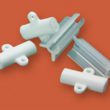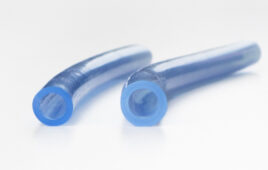Biocompatibility, flexibility and durability make extruded silicone a top medical device tubing choice. Keep these six things in mind when reinforcing it.
Dan Sanchez, Trelleborg Sealing Solutions

Kink-resistant tubing provides a pathway for fluids to enter into and from the body. It must meet mechanical requirements such as adequate hoop strength and flexibility to conform to anatomical features. [Image courtesy of Trelleborg]
Here are six things to keep in mind about reinforced silicone tubing:
1. Spiral design adds kink resistance
Silicone is a soft material, and extrudable silicones are in the Shore-A durometer scale. This makes them prone to kinking, especially in small dimensions. As designs call for smaller device footprints and tubes as a result become smaller, tube diameters reach the point where, without reinforcement, they easily bend or collapse, halting the flow of fluid.
The solution is to embed monofilaments, either in a spiral or braided design, within the wall of the tube to add radial strength, making extruded silicone tubes highly resistant to kinking and compression. Today, small silicone tubes (1/8 in. to 3/16 in.) are available with a variety of reinforcements.
Monofilaments in a tight spiral design are ideal for adding kink resistance to small diameter tubes. The reinforcement adds enough radial strength so that tubing can be bent almost in half without affecting fluid flow. Because the monofilaments are embedded in the tube wall, they do not affect the inner diameter of the tube. This configuration is ideal for creating a small, highly flexible tube that will not kink or collapse, even when required to conform around anatomical features.
However, plastic reinforcements are sensitive to heat, so they cannot be used in devices that will be subjected to high temperatures, such as seen in autoclave sterilization. The silicone itself is highly heat resistant, but the autoclave’s high temperature would degrade the mechanical performance of the plastic embedded in the wall. In addition to plastic, spiral reinforcements can be manufactured from nylon and stainless steel, both of which are more heat resistant than plastic.
2. Braids prevent burst tubes
Some medical applications require tubes that are slightly less flexible than those that can be produced by spiral reinforcement but which are stronger. Rather than kink resistance, the aim is to produce a tube that won’t expand, burst or collapse under pressure. The solution is a braided monofilament, which can be constructed from a variety of plastics and metals, including polyethylene, nylon and stainless steel.
The flexibility of a braided monofilament depends on the number of crossed pieces in a given area. This is typically measured in per-inch crosses, or PICs. The higher the PICs, the tighter the braid; the tighter the braid, the less flexible the tube but the stronger it will be.
3. Reinforcers extend durability
Reinforced tubing can also be designed to increase wear resistance. Materials such as polyester and polyethylene can be placed inside the silicone wall in a spiral or braid configuration for tubes to be used inside the body.
An application example is where excess tubing is coiled up and placed behind a pacemaker in the chest cavity. This may rub against the pacemaker due to arm/shoulder movement and over time, this can cause the outer layer of silicone to break down. A smooth, durable reinforcement placed inside the silicone makes the tube considerably more wear resistant, extending the length of time the device can function inside the body before surgical replacement.
4. Designing with mandrels in mind
Unlike thermoplastics, which must be melted to an exact point before extrusion and then cooled quickly to set the shape, high consistency “rubbers”/elastomers (HCR/Es) silicones are a thermoset material that rely on a chemical crosslinking process. HCEs have considerable green strength, making them an ideal material for extrusion, but once crosslinked with heat, they will not re-melt.
However, the reinforcement process adds a layer of complexity to tubing manufactures. The tube wall must be built on a mandrel while the spiral or braid is being created. The mandrel is removed once the reinforcement is complete.
Removing the mandrel from the tube can be difficult for long lengths of tubing, limiting the length of certain types of reinforced tubing. When long lengths are specified, one solution is to deliver the tube with the mandrel still inside. The customer cuts the tube to length, then removes the mandrel.
The size of the inner diameter (ID) is also a factor: Larger tube IDs require a larger mandrel. As the mandrel increases in size, the surface area’s contact with the silicone enlarges significantly, increasing friction and making the mandrel more difficult to remove. Thus, the use of reinforcement in silicone tubes is currently limited to under 1/8 in. in diameter.
Thicker walls can also have a negative impact on removing the mandrel because they may have a tighter grip on the mandrel, increasing the friction coefficient between the silicone wall and the mandrel.
5. Keeping an eye on loose ends
Because silicone doesn’t easily bond to other materials, the reinforcements described above are encapsulated in the silicone walls but not chemically bonded to them.
This is not a concern for applications where both ends of the reinforced tube are attached to another part of the device. However, if the tube were to be unattached at one end, it might need to be sealed through a secondary process to ensure that non-biocompatible (and possibly sharp) monofilaments don’t come into contact with the body or bodily fluids.
6. Considering colors and coatings
Silicone is naturally clear or translucent, but tubes can be pigmented in a variety of opaque or translucent colors. However, when specifying a reinforced tube, it’s wise to choose one that is clear, translucent or has a translucent color. This ensures the reinforcement can be easily inspected to ascertain whether or not the correct number of coils in a spiral (or PICs in a braid) are present in the reinforcement.
A variety of silicone coatings are also available. Other than the heat necessary to cure the coating, there are no additional obstacles to coating a reinforced tube. Because uncoated silicone tubes tend to have a slightly tacky surface, friction-reducing surface coatings are often added to reduce friction within the device or within the body.
In summary, silicone’s natural flexibility lends itself to tubing, with extrusions from 20 durometers to 80 durometers possible on the Shore-A scale. (20-A durometer is not recommended due to increased lot variability, gel presence, and difficulty in processing.) As long as you understand the advantages and limitations, there are a variety of reinforcements and coatings that can enhance silicone tubing even more.
Dan Sanchez is an R&D engineering manager, principal engineer at Trelleborg Sealing Solutions.





